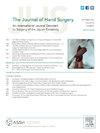A Percutaneous Triple K-Wire Fixation Technique for Nascent Malunion of Proximal Interphalangeal Joint Fracture-Dislocation: A Case Series With an Assessment of Functional Outcome
IF 2.1
2区 医学
Q2 ORTHOPEDICS
引用次数: 0
Abstract
Purpose
Fracture-dislocations of the proximal interphalangeal (PIP) joint are difficult to manage. In the case of a 2- to 4-week delay in definitive treatment, a nascent malunion may result. This study aimed to evaluate the effectiveness of the percutaneous triple K-wire technique for treatment of the PIP joint nascent malunion.
Methods
We treated 13 patients with nascent malunion of PIP joint fracture-dislocations using the percutaneous triple K-wire fixation technique based on the principle of soft callus manipulation to achieve congruity and reduction in the joint. The study included cases where the percentage of articular involvement exceeded 40% and in whom there was a minimum follow-up of 12 months. At the final follow-up, we measured the range of motion at the PIP joint. The Ishida and Ikuta scores were determined.
Results
The mean period between injury and surgery was 17.2 days. The average follow-up time was 14.2 months. The mean active arc of motion before surgery in the PIP joint was 15 degrees and that at the final follow-up was 83 degrees. Seven patients achieved excellent outcomes according to the Ishida and Ikuta scores. The final postoperative range of motion at the PIP joint was comparable with that reported in the literature for patients who underwent different procedures.
Conclusions
This procedure can be considered a viable alternative to open reduction and plating, hemihamate arthroplasty, and ligamentotaxis with distraction, particularly in the presence of nascent malunion.
Type of study/level of evidence
Therapeutic IV.
经皮三K线固定技术治疗近端指间关节骨折-脱位的新近愈合:评估功能结果的病例系列。
目的:近端指间关节(PIP)骨折脱位很难处理。如果延误 2 至 4 周进行明确治疗,可能会导致新生骨不连。本研究旨在评估经皮三K线技术治疗PIP关节新生错位的有效性:方法:我们采用经皮三K线固定技术治疗了13例PIP关节骨折脱位新生错位患者,该技术基于软胼胝操作原则,以实现关节的一致性和复位。研究对象包括关节受累比例超过 40%、随访时间至少 12 个月的病例。在最后的随访中,我们测量了拇指关节的活动范围。结果:受伤与手术之间的平均间隔时间为 17.2 天。平均随访时间为 14.2 个月。手术前,PIP关节的平均活动弧度为15度,最后随访时为83度。根据石田(Ishida)和生田(Ikuta)的评分,有七名患者获得了极佳的疗效。术后PIP关节的最终活动范围与文献中报道的接受不同手术的患者的活动范围相当:结论:该手术可被视为切开复位和钢板固定术、半髋关节置换术和韧带牵引术的可行替代方案,尤其是在出现新生关节错位的情况下:治疗 IV.
本文章由计算机程序翻译,如有差异,请以英文原文为准。
求助全文
约1分钟内获得全文
求助全文
来源期刊
CiteScore
3.20
自引率
10.50%
发文量
402
审稿时长
12 weeks
期刊介绍:
The Journal of Hand Surgery publishes original, peer-reviewed articles related to the pathophysiology, diagnosis, and treatment of diseases and conditions of the upper extremity; these include both clinical and basic science studies, along with case reports. Special features include Review Articles (including Current Concepts and The Hand Surgery Landscape), Reviews of Books and Media, and Letters to the Editor.

 求助内容:
求助内容: 应助结果提醒方式:
应助结果提醒方式:


